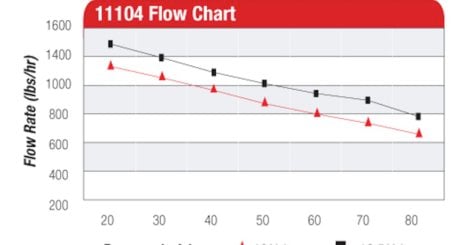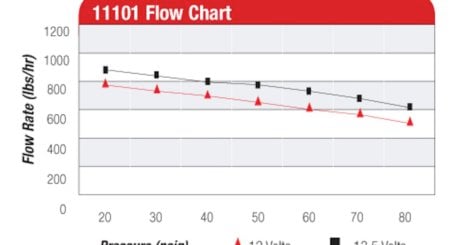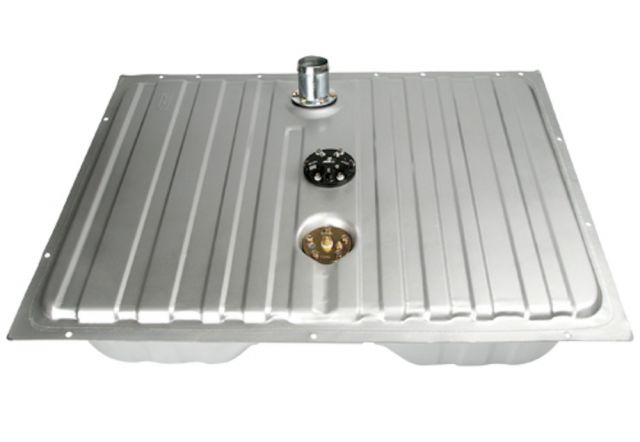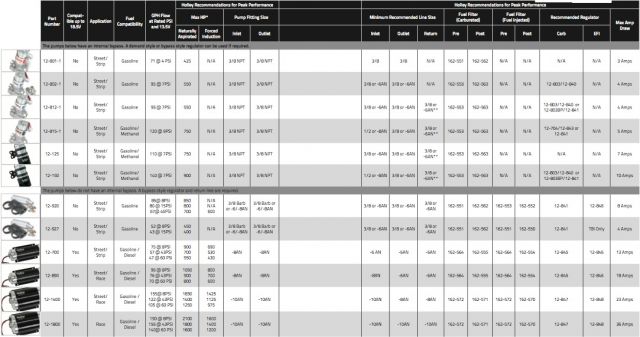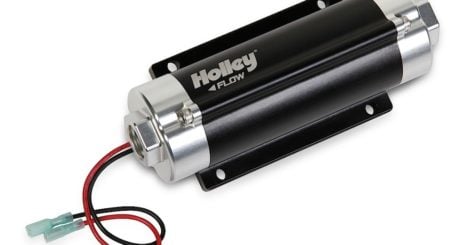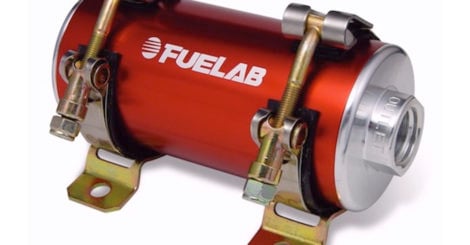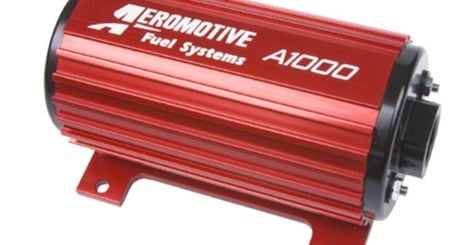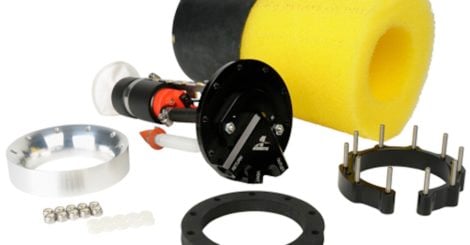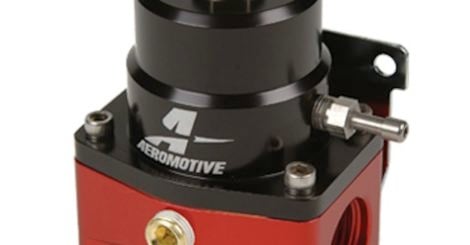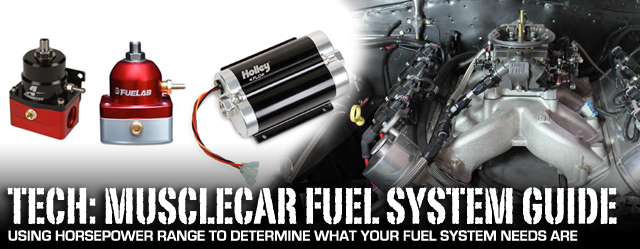 [1]
[1]
Stock fuel systems can often only support limited additional power. Determining which fuel system parts you need though can be a daunting task. Flow rates, fuel pressure, volume, filters, line sizes and even the tank all play a crucial role in your high performance car’s fuel system. We went to three of the top names in street and high performance fuel systems, Aeromotive [2], FueLab [3], and Holley [4], and they gave us the rundown on picking the right fuel components for your musclecar project needs.
Pump Ratings
Deciphering fuel pump information and understanding what it all means are critical elements to determining which fuel pump is best suited for your application.
Flow Rates
Technically you could keep a 747 jet in the air on 400 gallons per hour. -Rob Scharfenberg, FueLab
Fuel pumps are often advertised with flow rates in gallons per hour or pounds per hour. For example you might see a fuel pump advertised with 400 gallons per hour capacity. This can be misleading, however, as FueLab engineer Rob Scharfenberg points out, “Technically you could keep a 747 jet in the air on 400 gallons per hour,” he said.
What is typically advertised for fuel pumps is their free flow rate. This is the amount of fuel they can flow unrestricted, not what they can flow at the pressure that the engine needs to operate correctly.
As fuel pressure increases, the flow rate actually drops off. Carbureted engines typically run 10 percent or less the fuel pressure of their EFI counterpart of the same power output. As fuel pressure rises, flow decreases because the volume of fuel required to maintain the pressure is higher. “You’re still consuming the same amount of fuel just at different pressures. With EFI, because of the higher pressure your flow rate actually goes down”, says Jay McFarland of Holley [5]. This means that EFI engines require higher capacity pumps than their carbureted counterparts.
These charts from Aeromotive demonstrate the differences in fuel flow rates at different voltages and pressures. This helps illustrate part of why a pump may have varying horsepower ratings depending on EFI or carburetor application.
Free Flow vs Working Flow
Think of free flow as a water hose with no nozzle on the end. You can flood the driveway in a hurry, but it’s lousy, and wasteful for washing your car. What you really need is working flow, in the case of washing the car, higher water pressure to blast away road grime on demand. The same holds true for fuel pumps, you need adequate flow to support the pressure that is demanded. Free flow ratings are of little importance if the pump can’t support the pressure needed.
Working flow is the amount of fuel that your engine actually needs. While a fuel pump may be capable of flowing fire hose amounts of fuel when unrestricted, your engine in actuality may only require 20-40% of that amount of fuel. Scharfenberg tells us, “It’s really not as much a question of flow as it is being able to maintain consistent and stable pressure.”
Determining Needed Flow
Selecting the proper pump though, is not solely a matter of determining fuel pressure and flow, or even how much horsepower an engine is making. It’s also a question of engine efficiency, more specifically the engine’s Break Specific Fuel Consumption, or BSFC. This is a measurement of how much fuel the engine will burn to produce one horsepower in one hour. Brett Clow, of Aeromotive [8], tells us BSFC is key in selecting the proper fuel pump. “When I think about how much fuel an engine is going to burn, I am thinking about the fuel that is actually being burned in the cylinder,” he says.
Engine builders determine an engine’s BSFC using an engine dyno, and measuring equipment to see how much fuel an engine consumes over a specific period of time. BSFC though, is also affected by the specific gravity of a fuel, which is different for each type of fuel.
If the exact BSFC is not known, Clow will often work from a set of numbers to get reasonably close to most engine’s BSFC, based off his years of experience with fuel systems. Those average BSFC numbers are:
- .5 naturally aspirated
- .55 nitrous
- .6 for turbo
- .65 for supercharged
Using those BSFC figures you can determine the amount of fuel flow your pump will need to be capable of. Simply multiply the flywheel horsepower by the number that corresponds with your type of engine. Using Clow’s guidelines, a supercharged 600 hp engine with an assumed BSFC of .65, would need a fuel pump capable of flowing 390 lbs per hour of fuel.
Clow recommends erring on the side of caution to avoid leaning out and damaging an engine. By contrast a naturally aspirated 600 hp engine would only have a fuel need of 300 lbs per hour. You can start to see how and why there are differences in power ratings for the same pump depending on your car’s setup.
Fuel injected owners can take this mathematical exercise one step further and determine their injector size needs. Simply divide the pounds per hour necessary by the number of injectors being used. Using our previous supercharged example, a V-8 with eight injectors would need 48lb per hour injectors at peak power.
To be safe, Clow also recommends figuring the size of the injector at 80% duty cycle, meaning to slightly oversize your injectors. To do this simply divide your injector rating, in this case 48, by 0.8, this gives 60, which in turn means that to avoid maxing out the fuel injectors at peak horsepower, use a 60 lbs/hour injector. This allows for both a safety margin, as well as the injectors to run cooler, which should prolong their life.
Pump Types
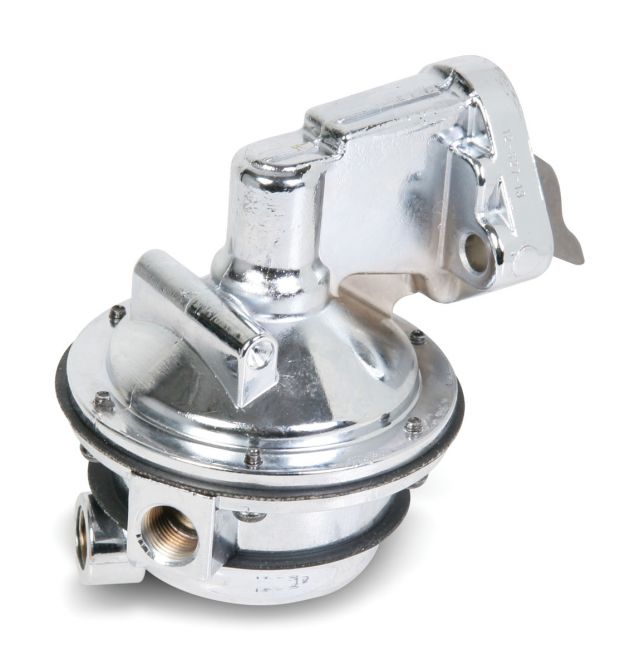 [11]
[11]This Holley 12-327-13 mechanical pump flows 130 gallons per hour and can handle up to 450 HP naturally aspirated on a carbureted engine.
Fuel pump types can be broken down into two categories: mechanical and electrical. While there are variations of each, we’re going to stick with the most commonly used pumps for this discussion.
Mechanical
Mechanical pumps are attached to the timing cover or engine, and are typically driven by an eccentric that is turned by the camshaft. An upgraded mechanical pump can keep up with carbureted demand on modified vehicles to a point. McFarland tells us, “Carbureted cars can run a mechanical pump easily up to about 450 hp, beyond that we would recommend an electric pump.”
For engines making up to 300 hp Holley recommends a mechanical pump that can supply in the neighborhood of 80 gallons per hour. For engines making up to 450 hp, a pump with up to 110 gallons per hour should be sufficient.
There are stumbling blocks when it comes to using an eccentric driven mechanical pump. For one, they are limited in the amount of power that they can support for the money. While there are mechanical pumps out there capable of supporting high levels of horsepower, those come at extreme expense, often well above the cost of converting to an electric pump system.
Another very limiting factor is the eccentric drive, “A mechanical pump will flow as much or more fuel at idle as it will anywhere else in the RPM curve,” says Clow. This is because as the engine RPM increases, the pump arm that is acted upon by the eccentric may begin to float, never fully returning back to starting position, thus never completing a full cycle. This means that there is potential at higher engine speeds for fuel starvation due to lack of volume being supplied to the carburetor.
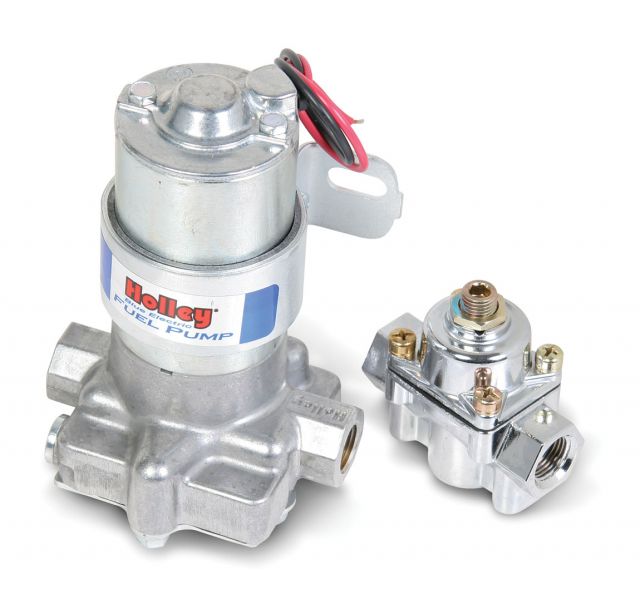 [12]
[12]Holley's Blue pump, 12-802-1 has been a favorite of carburetor enthusiasts looking to upgrade from a mechanical pump for many years. It can flow 88 gallons per hour at 9 psi.
Electric Pumps
There are two main types of electric pumps, in-tank and external. Until recent years, the in-tank type was limited to lower output pumps, these pumps typically could support anywhere from the 450-600 hp range. They were often restricted by the OEM fuel lines, or other components in the system. In some cases, these add ons or OEM replacements can actually run the fuel basket in the pump dry, further complicating things.
In recent years, submersible and newer in-tank system’s like Aeromotive’s Stealth [13], and Phantom fuel systems [14], have caused renewed interest for in-tank fuel systems.
Left: The Holley In-Line billet pump. Center Left: The FueLab Prodigy pump. Center Right: Aeromotive's A1000 pump. Far Right: Aeromotive's new Phantom Stealth system can be installed in a new or existing tank.
With electric fuel pumps the available voltage also affects the amount of power to the fuel pump. Assuming the pump is wired properly, the fuel flow may increase by as much as 40% when voltage goes from 12 volts to 13.5 volts, as is typical with most properly working modern alternators. The increased voltage increases the RPM of the fuel pump, thus increasing it’s available torque allowing it to overcome the strain of running higher pressures.
Power Adders
Forced induction will increase the engine’s demand for fuel volume, and may also require changes in fuel pressure. The increased volume of air means the engine can also burn more fuel, and must do so to avoid running lean. Running forced induction changes the engine’s BSFC, thus changing the requirements for the amount of fuel the engine will consume. Stepping up the fuel pump is most likely the minimal requirement for any type of forced induction system.
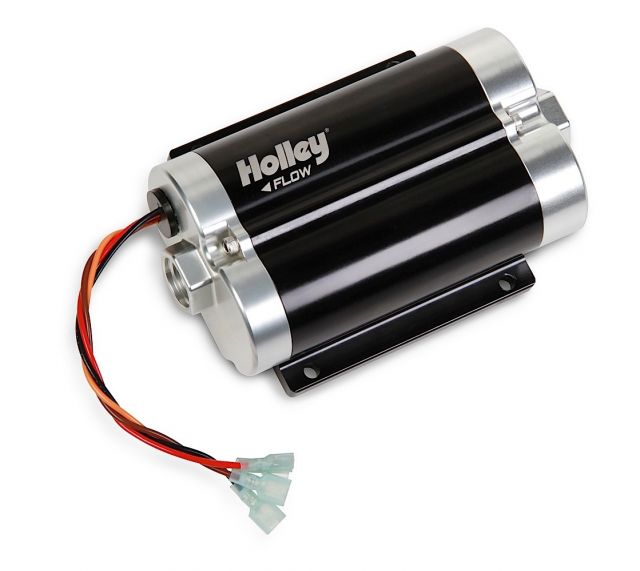 [19]
[19]Holley's Dominator fuel pump is a new twist on thinking in the fuel pump market. Its twin pump design allows both pumps to be run simultaneously, or have the second pump activated manually or automatically as fuel needs are increased.
Similar principles hold true for nitrous oxide, again because of it’s affect on BSFC. However, with nitrous there are other precautions to take. Not only is the engine’s demand for fuel increased, if the nitrous is a wet system, and draws fuel from the same supply and pump as the rest of the fuel system, there is a chance that the fuel volume could be inadequate, as well the pressure could drop off. This is where the pump should be matched to the vehicle’s output. Better still, a small dedicated, low pressure fuel system for the nitrous fuel solenoids can also be a good idea.
Filters
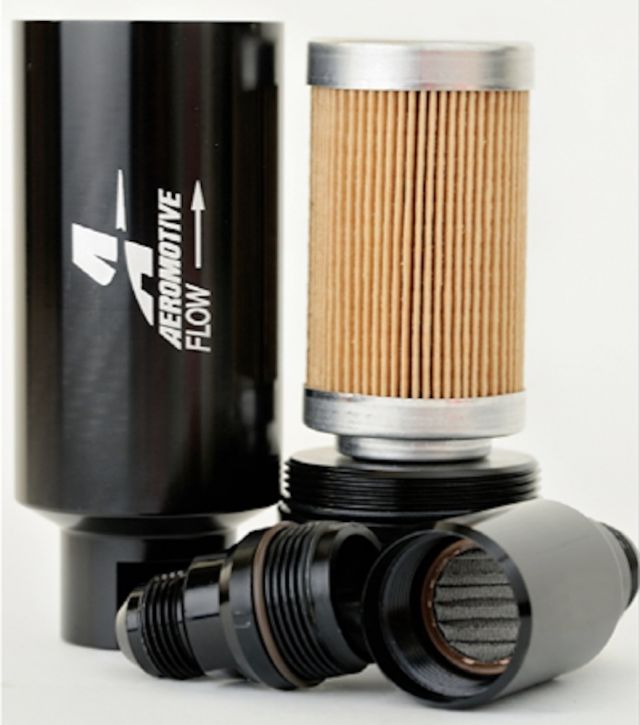 [20]
[20]Fuel filters need to have a greater amount of flow at the fuel pump inlet. The elements should feature a large surface area, and the inlet and outlet sizes should be matched to the rest of the fuel system.
Every manufacturer we talked with recommended a pre- and post-pump fuel filter, regardless of the type of pump used. This is an area where careful planning and precautions must also be taken. A mismatch can cause extreme damage to fuel pumps, or even your engine.
The pre-pump filter needs to be a high flowing filter. It needs to keep up with flow demands of the pump and not cause an inlet restriction. Inlet restrictions create a vacuum condition which will lower the output pressure of the fuel pump. Lower pressure also equals a lower boiling point of the fuel. This can potentially lead to a vapor lock, causing loss of fuel pressure, lean condition, or engine stalling.
It’s important to understand that not all filters are the same. First you must consider the micron size. Micron is the measurement of the porosity of the filter media. The higher this number the larger the holes, thus more flow. The lower the number, the smaller the holes, which equals higher filtration, but the trade off is also a flow restriction. Filters should also have a large surface area of filter media. In most cases, it’s recommended that media be at least 60 square inches.
When I think about how much fuel an engine is going to burn, I am thinking about the fuel that is actually being burned in the cylinder. -Brett Clow, Aeromotive
Post pump filters must also be matched to the application. They need to avoid a severe fuel pressure drop. This is where a restriction caused by the post pump filter causes pressure to build up at the pump outlet, and drop off significantly past the post pump filter. This builds up heat in the pump, draws more current, and shortens pump life. Depending on the application a filter with between 10 and 40 microns with a surface area of 60 square inches is generally recommended for the post pump filter.
Regulators
While there are still dedicated regulators for carbureted or fuel injected systems only, many companies are offering regulators capable of controlling either type of system. The fuel pressure regulator should be viewed as another part of the system that must be matched, just as the pump and filter.
“Get a regulator that is sized properly for the fuel pump. You don’t want a regulator that is a restriction in the fuel system,” says McFarland. In fact the regulator should be matched in flow potential, pressure capability and line size, with the rest of the fuel system. It must be capable of flowing the correct volume and pressure of fuel to the engine.
Dead Head regulators stall fuel flow until the needle in the carburetor moves to return demand. Fuel is circulated either internally at the pump or via a return from the pump back into the fuel system. These regulators do not have a fuel return port. An important tech note: no matter which type of regulator you are using, it's important to mount it as close to the fuel rail as possible on any fuel system.
Dead Head
Dead head regulators are for single line systems with carburetors. These systems stall fuel flow at idle when demand is low, causing the pump to recirculate fuel until the engine RPM increases and demand returns. These work well in some applications but have several draw backs.
Get a regulator that is sized properly for fuel pump. You don’t want a regulator that is a restriction in the fuel system. -Jay McFarland, Holley
The fuel can get extremely hot in the fuel line, causing the potential for vapor lock. Next is the strain on the pump; this type of regulator increases strain on the pump as pressure is built inside the line, the pump must continually recirculate the fuel. Last is flow vs. g-force. In racing, or high horsepower applications, a dead head regulator requires a more robust pump to overcome the g-force working against it to deliver fuel to the fuel line and into the carburetor when the car goes from a stand still to accelerating. If the pump is not strong enough to overcome this, a lean condition, lack of power, or stall may result.
Dynamic
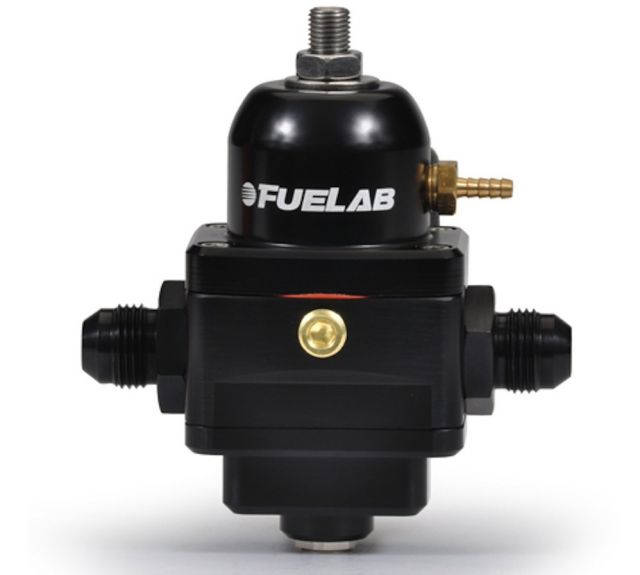 [23]
[23]The 529 series regulator from FueLab is an innovative way to manage a fuel system. This regulator actually controls the fuel pump, signaling it to increase fuel flow when demand rises, and decrease flow under low demand.
Dynamic fuel pressure regulators are those that involve both a supply and return line. These regulators constantly return unused fuel either back to the pump or the tank. The key advantage to a dynamic regulator is that there is always constant flow and pressure as long as the pump is operating. The only disadvantage is that a return line must be incorporated into the fuel system. Dynamic regulators are used for both EFI and carbureted systems.
Lines
The best fuel pump, filters and regulator are of little use if the method for their delivery is inadequate. Fuel lines must be matched to the size of the pump outlet, as well as to the flow and pressure requirements of the fuel system. Inside diameter, and length of the line both have an impact on how well the fuel pump can deliver fuel. OEM lines were only intended to support OEM power levels. As such, tasking those lines with supplying fuel to an engine that now makes 50% or more power than it did from the factory is like asking the fire department to put out a 4-alarm fire with your garden hose.
These guidelines are a good starting point for selecting fuel lines:
- -6 AN up to 550 hp
- -8 AN over 550 hp
- -10 AN 1000+ hp
An easy way to associate the AN line size to the actual size of a fuel hose is to remember that every dash (-) is 1/16 of an inch. So a -6 AN line is 6/16 of an inch, or 3/8. A -10 AN fitting would support a 10/16-inch fuel line, which is a 5/8-inch fuel line.
The Bottom Line
Fuel systems are often an after thought in the process of many builds. Hopefully now you can see that fuel system components should be considered just as carefully as an engine build. Each part matched based on the others, and the needs of the engine. You don’t need the biggest pump, or the most expensive components, but spending the time and money on proven quality components will eliminate future problems and give your car more consistent and reliable performance.
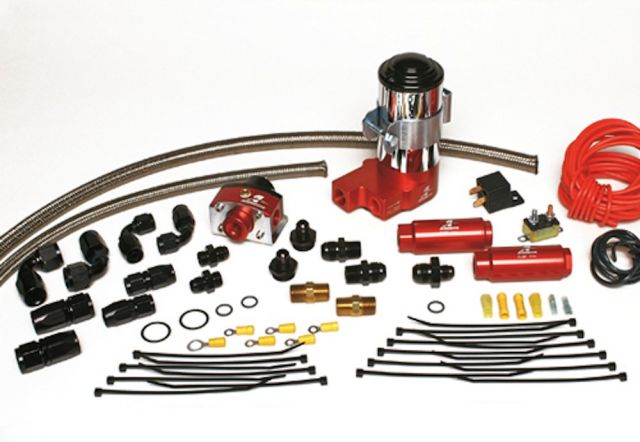 [24]
[24]Fuel components need to be thought of and selected a complete system, taking every part into account. Doing this ensures that the system works in harmony and supplies the engine with the correct amount of fuel under all driving conditions.

